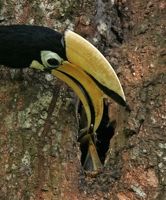Have you ever seen a wild Hornbill with your own eyes before?
Not through TV or in Zoo but in the Wild?
For sure you will think that where the heck am I going to look for Hornbill since they live in the forest....
Well, good news is hornbills actually do live in URBAN area too!!!
Today I would like to talk about a Hornbill that can be found on islands and in coastal area- the Oriental Pied Hornbill, Anthracoceros albirostris.

Oriental Pied Hornbill is distingiush from other hornbills with its black marks on their white bill of both sexes and their white belly.
So, next time when you saw a hornbill with black marks on their white bill, you can proudly tell your friends that that is an Oriental Pied Hornbill! xp

Where can you found them?
If you living in Kota Kinabalu, or you are visiting Kota Kinabalu, you don't really have to go into the wild or forest just to look for them!
You can just visit the Tanjung Aru First Beach and you can see them flying above your head or standing on a tree just on top of you.
Yup!!!! It's the place where locals and tourist like to hang out and have meal!!!!
But to pay them a visit, I recommend to visit them during the morning, best before 10am where there are less crowded along the beach with less human disturbance.

An Oriental Hornbill perching on the wall beside the food stalls at Tanjung Aru beach.

A female and male Oriental Hornbill perching on the Lamp post.
How to differentiate between male and female Oriental Hornbill?
Well, it is quite easy~
Male has larger "horn" while female has smaller "horn" and has red or brownish marks at their lower bill which is absent in male.
Well, the male have black mark only on the horn, while the female have black marks on both the horn and on the bills too.
So, the left hornbill in the picture is the female while the right one is the male.
Hornbills are actually very loyal towards their mating couple.
Male Hornbills can be said as "Family" concentrated bird.
Why do I said so?
This is because the female will be sealed inside a cavity with her feather shed away after she lay her eggs!
She has to depend mainly on the male to feed her and her chicks to survive as she can't fly during the nesting period!
This proves that Male Horbills are very loyal as they won't abandon their mate and chicks.
Before mating, Oriental Pied Hornbill will carry out courtship feeding and in the search for a suitable nesting cavity.
The male oriental pied hornbill will lure the female hornbill into the nesting cavity and he needs to convince the female that he is capable of feeding her once she is sealed in the cavity.
He will demonstrate to feed at the cavity or placing food inside.
Once the female is convinced, she will fly in and clean the interior of the cavity.
Then the birds will mate.
After that, the female will the sealed inside the cavity with mud and feces living only a narrow opening for the male to pass the food to her.
She will then lay her eggs and shed her feathers.
The sealing of female inside the cavity is one of the strategy to prevent from predators, prevent the cavity from flood of water and keep out competitor which may take over the nest (Kinnarid & O'Brien, 2007).
After 29 day of incubation and 2 months being sealed with the chicks, the female will reopens the cavity entrance and frees the young hornbills.
The parents will accompany their Chicks as they discover a whole new world.

However, the Hornbill population decreases drastically due to hunting and deforestation over the decade.
If the male is hunted and died during the nesting period, then the female and chicks will eventually die too due to starvation.
One down then the whole family down..
So, please do not support any traiting of Hornbill product and help conserve this family "loving" creature!
If you are interested in birding, Tanjung Aru beach and the Prince Philips park beside the Tanjung Aru First Beach are good places to start with.
There are Hornbills, Parrots, Kingfisher, Dollar Birds and many other birds which you can see it easily even without using a binocular.
So, this is my first post on Birds Fact!
Hope you guys will love it. :)
And Happy Birding!!!
Reference:
1. Kinnaird, M.F. & O'Brien, T. G. 2007. The ecology and conservation of Asian Hornbills: Farmers of the Forest. The University of Chicago Press: London.
2. Phillipps, Q. & Phillipps, K. 2011. Phillipps' Field Guide To The Birds of Borneo. John Beaufoy Publishing: London.






No comments:
Post a Comment